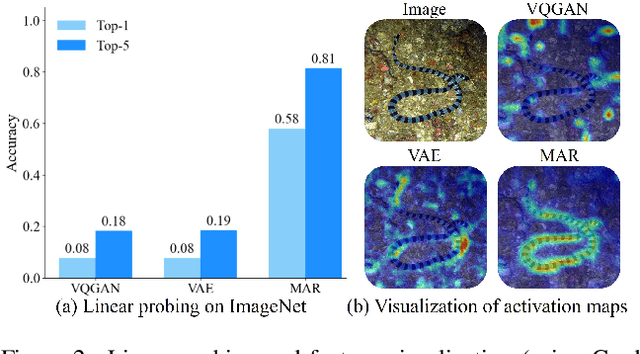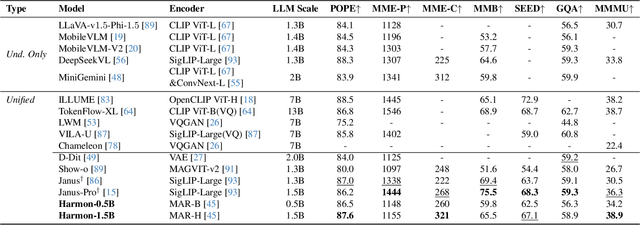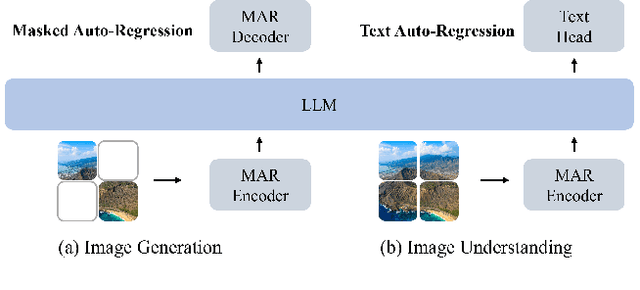Wenwei Zhang
InternVL3.5: Advancing Open-Source Multimodal Models in Versatility, Reasoning, and Efficiency
Aug 25, 2025Abstract:We introduce InternVL 3.5, a new family of open-source multimodal models that significantly advances versatility, reasoning capability, and inference efficiency along the InternVL series. A key innovation is the Cascade Reinforcement Learning (Cascade RL) framework, which enhances reasoning through a two-stage process: offline RL for stable convergence and online RL for refined alignment. This coarse-to-fine training strategy leads to substantial improvements on downstream reasoning tasks, e.g., MMMU and MathVista. To optimize efficiency, we propose a Visual Resolution Router (ViR) that dynamically adjusts the resolution of visual tokens without compromising performance. Coupled with ViR, our Decoupled Vision-Language Deployment (DvD) strategy separates the vision encoder and language model across different GPUs, effectively balancing computational load. These contributions collectively enable InternVL3.5 to achieve up to a +16.0\% gain in overall reasoning performance and a 4.05$\times$ inference speedup compared to its predecessor, i.e., InternVL3. In addition, InternVL3.5 supports novel capabilities such as GUI interaction and embodied agency. Notably, our largest model, i.e., InternVL3.5-241B-A28B, attains state-of-the-art results among open-source MLLMs across general multimodal, reasoning, text, and agentic tasks -- narrowing the performance gap with leading commercial models like GPT-5. All models and code are publicly released.
InternBootcamp Technical Report: Boosting LLM Reasoning with Verifiable Task Scaling
Aug 12, 2025



Abstract:Large language models (LLMs) have revolutionized artificial intelligence by enabling complex reasoning capabilities. While recent advancements in reinforcement learning (RL) have primarily focused on domain-specific reasoning tasks (e.g., mathematics or code generation), real-world reasoning scenarios often require models to handle diverse and complex environments that narrow-domain benchmarks cannot fully capture. To address this gap, we present InternBootcamp, an open-source framework comprising 1000+ domain-diverse task environments specifically designed for LLM reasoning research. Our codebase offers two key functionalities: (1) automated generation of unlimited training/testing cases with configurable difficulty levels, and (2) integrated verification modules for objective response evaluation. These features make InternBootcamp fundamental infrastructure for RL-based model optimization, synthetic data generation, and model evaluation. Although manually developing such a framework with enormous task coverage is extremely cumbersome, we accelerate the development procedure through an automated agent workflow supplemented by manual validation protocols, which enables the task scope to expand rapidly. % With these bootcamps, we further establish Bootcamp-EVAL, an automatically generated benchmark for comprehensive performance assessment. Evaluation reveals that frontier models still underperform in many reasoning tasks, while training with InternBootcamp provides an effective way to significantly improve performance, leading to our 32B model that achieves state-of-the-art results on Bootcamp-EVAL and excels on other established benchmarks. In particular, we validate that consistent performance gains come from including more training tasks, namely \textbf{task scaling}, over two orders of magnitude, offering a promising route towards capable reasoning generalist.
Semi-off-Policy Reinforcement Learning for Vision-Language Slow-thinking Reasoning
Jul 22, 2025Abstract:Enhancing large vision-language models (LVLMs) with visual slow-thinking reasoning is crucial for solving complex multimodal tasks. However, since LVLMs are mainly trained with vision-language alignment, it is difficult to adopt on-policy reinforcement learning (RL) to develop the slow thinking ability because the rollout space is restricted by its initial abilities. Off-policy RL offers a way to go beyond the current policy, but directly distilling trajectories from external models may cause visual hallucinations due to mismatched visual perception abilities across models. To address these issues, this paper proposes SOPHIA, a simple and scalable Semi-Off-Policy RL for vision-language slow-tHInking reAsoning. SOPHIA builds a semi-off-policy behavior model by combining on-policy visual understanding from a trainable LVLM with off-policy slow-thinking reasoning from a language model, assigns outcome-based rewards to reasoning, and propagates visual rewards backward. Then LVLM learns slow-thinking reasoning ability from the obtained reasoning trajectories using propagated rewards via off-policy RL algorithms. Extensive experiments with InternVL2.5 and InternVL3.0 with 8B and 38B sizes show the effectiveness of SOPHIA. Notably, SOPHIA improves InternVL3.0-38B by 8.50% in average, reaching state-of-the-art performance among open-source LVLMs on multiple multimodal reasoning benchmarks, and even outperforms some closed-source models (e.g., GPT-4.1) on the challenging MathVision and OlympiadBench, achieving 49.08% and 49.95% pass@1 accuracy, respectively. Analysis shows SOPHIA outperforms supervised fine-tuning and direct on-policy RL methods, offering a better policy initialization for further on-policy training.
The Imitation Game: Turing Machine Imitator is Length Generalizable Reasoner
Jul 17, 2025Abstract:Length generalization, the ability to solve problems of longer sequences than those observed during training, poses a core challenge of Transformer-based large language models (LLM). Although existing studies have predominantly focused on data-driven approaches for arithmetic operations and symbolic manipulation tasks, these approaches tend to be task-specific with limited overall performance. To pursue a more general solution, this paper focuses on a broader case of reasoning problems that are computable, i.e., problems that algorithms can solve, thus can be solved by the Turing Machine. From this perspective, this paper proposes Turing MAchine Imitation Learning (TAIL) to improve the length generalization ability of LLMs. TAIL synthesizes chain-of-thoughts (CoT) data that imitate the execution process of a Turing Machine by computer programs, which linearly expands the reasoning steps into atomic states to alleviate shortcut learning and explicit memory fetch mechanism to reduce the difficulties of dynamic and long-range data access in elementary operations. To validate the reliability and universality of TAIL, we construct a challenging synthetic dataset covering 8 classes of algorithms and 18 tasks. Without bells and whistles, TAIL significantly improves the length generalization ability as well as the performance of Qwen2.5-7B on various tasks using only synthetic data, surpassing previous methods and DeepSeek-R1. The experimental results reveal that the key concepts in the Turing Machine, instead of the thinking styles, are indispensable for TAIL for length generalization, through which the model exhibits read-and-write behaviors consistent with the properties of the Turing Machine in their attention layers. This work provides a promising direction for future research in the learning of LLM reasoning from synthetic data.
Rethinking Verification for LLM Code Generation: From Generation to Testing
Jul 09, 2025Abstract:Large language models (LLMs) have recently achieved notable success in code-generation benchmarks such as HumanEval and LiveCodeBench. However, a detailed examination reveals that these evaluation suites often comprise only a limited number of homogeneous test cases, resulting in subtle faults going undetected. This not only artificially inflates measured performance but also compromises accurate reward estimation in reinforcement learning frameworks utilizing verifiable rewards (RLVR). To address these critical shortcomings, we systematically investigate the test-case generation (TCG) task by proposing multi-dimensional metrics designed to rigorously quantify test-suite thoroughness. Furthermore, we introduce a human-LLM collaborative method (SAGA), leveraging human programming expertise with LLM reasoning capability, aimed at significantly enhancing both the coverage and the quality of generated test cases. In addition, we develop a TCGBench to facilitate the study of the TCG task. Experiments show that SAGA achieves a detection rate of 90.62% and a verifier accuracy of 32.58% on TCGBench. The Verifier Accuracy (Verifier Acc) of the code generation evaluation benchmark synthesized by SAGA is 10.78% higher than that of LiveCodeBench-v6. These results demonstrate the effectiveness of our proposed method. We hope this work contributes to building a scalable foundation for reliable LLM code evaluation, further advancing RLVR in code generation, and paving the way for automated adversarial test synthesis and adaptive benchmark integration.
RIG: Synergizing Reasoning and Imagination in End-to-End Generalist Policy
Mar 31, 2025Abstract:Reasoning before action and imagining potential outcomes (i.e., world models) are essential for embodied agents operating in complex open-world environments. Yet, prior work either incorporates only one of these abilities in an end-to-end agent or integrates multiple specialized models into an agent system, limiting the learning efficiency and generalization of the policy. Thus, this paper makes the first attempt to synergize Reasoning and Imagination in an end-to-end Generalist policy, termed RIG. To train RIG in an end-to-end manner, we construct a data pipeline that progressively integrates and enriches the content of imagination and reasoning in the trajectories collected from existing agents. The joint learning of reasoning and next image generation explicitly models the inherent correlation between reasoning, action, and dynamics of environments, and thus exhibits more than $17\times$ sample efficiency improvements and generalization in comparison with previous works. During inference, RIG first reasons about the next action, produces potential action, and then predicts the action outcomes, which offers the agent a chance to review and self-correct based on the imagination before taking real actions. Experimental results show that the synergy of reasoning and imagination not only improves the robustness, generalization, and interoperability of generalist policy but also enables test-time scaling to enhance overall performance.
Harmonizing Visual Representations for Unified Multimodal Understanding and Generation
Mar 27, 2025



Abstract:Unifying visual understanding and generation within a single multimodal framework remains a significant challenge, as the two inherently heterogeneous tasks require representations at different levels of granularity. Current approaches that utilize vector quantization (VQ) or variational autoencoders (VAE) for unified visual representation prioritize intrinsic imagery features over semantics, compromising understanding performance. In this work, we take inspiration from masked image modelling (MIM) that learns rich semantics via a mask-and-reconstruct pre-training and its successful extension to masked autoregressive (MAR) image generation. A preliminary study on the MAR encoder's representation reveals exceptional linear probing accuracy and precise feature response to visual concepts, which indicates MAR's potential for visual understanding tasks beyond its original generation role. Based on these insights, we present \emph{Harmon}, a unified autoregressive framework that harmonizes understanding and generation tasks with a shared MAR encoder. Through a three-stage training procedure that progressively optimizes understanding and generation capabilities, Harmon achieves state-of-the-art image generation results on the GenEval, MJHQ30K and WISE benchmarks while matching the performance of methods with dedicated semantic encoders (e.g., Janus) on image understanding benchmarks. Our code and models will be available at https://github.com/wusize/Harmon.
SuperFlow++: Enhanced Spatiotemporal Consistency for Cross-Modal Data Pretraining
Mar 25, 2025Abstract:LiDAR representation learning has emerged as a promising approach to reducing reliance on costly and labor-intensive human annotations. While existing methods primarily focus on spatial alignment between LiDAR and camera sensors, they often overlook the temporal dynamics critical for capturing motion and scene continuity in driving scenarios. To address this limitation, we propose SuperFlow++, a novel framework that integrates spatiotemporal cues in both pretraining and downstream tasks using consecutive LiDAR-camera pairs. SuperFlow++ introduces four key components: (1) a view consistency alignment module to unify semantic information across camera views, (2) a dense-to-sparse consistency regularization mechanism to enhance feature robustness across varying point cloud densities, (3) a flow-based contrastive learning approach that models temporal relationships for improved scene understanding, and (4) a temporal voting strategy that propagates semantic information across LiDAR scans to improve prediction consistency. Extensive evaluations on 11 heterogeneous LiDAR datasets demonstrate that SuperFlow++ outperforms state-of-the-art methods across diverse tasks and driving conditions. Furthermore, by scaling both 2D and 3D backbones during pretraining, we uncover emergent properties that provide deeper insights into developing scalable 3D foundation models. With strong generalizability and computational efficiency, SuperFlow++ establishes a new benchmark for data-efficient LiDAR-based perception in autonomous driving. The code is publicly available at https://github.com/Xiangxu-0103/SuperFlow
Mask-DPO: Generalizable Fine-grained Factuality Alignment of LLMs
Mar 04, 2025Abstract:Large language models (LLMs) exhibit hallucinations (i.e., unfaithful or nonsensical information) when serving as AI assistants in various domains. Since hallucinations always come with truthful content in the LLM responses, previous factuality alignment methods that conduct response-level preference learning inevitably introduced noises during training. Therefore, this paper proposes a fine-grained factuality alignment method based on Direct Preference Optimization (DPO), called Mask-DPO. Incorporating sentence-level factuality as mask signals, Mask-DPO only learns from factually correct sentences in the preferred samples and prevents the penalty on factual contents in the not preferred samples, which resolves the ambiguity in the preference learning. Extensive experimental results demonstrate that Mask-DPO can significantly improve the factuality of LLMs responses to questions from both in-domain and out-of-domain datasets, although these questions and their corresponding topics are unseen during training. Only trained on the ANAH train set, the score of Llama3.1-8B-Instruct on the ANAH test set is improved from 49.19% to 77.53%, even surpassing the score of Llama3.1-70B-Instruct (53.44%), while its FactScore on the out-of-domain Biography dataset is also improved from 30.29% to 39.39%. We further study the generalization property of Mask-DPO using different training sample scaling strategies and find that scaling the number of topics in the dataset is more effective than the number of questions. We provide a hypothesis of what factual alignment is doing with LLMs, on the implication of this phenomenon, and conduct proof-of-concept experiments to verify it. We hope the method and the findings pave the way for future research on scaling factuality alignment.
Exploring the Limit of Outcome Reward for Learning Mathematical Reasoning
Feb 10, 2025Abstract:Reasoning abilities, especially those for solving complex math problems, are crucial components of general intelligence. Recent advances by proprietary companies, such as o-series models of OpenAI, have made remarkable progress on reasoning tasks. However, the complete technical details remain unrevealed, and the techniques that are believed certainly to be adopted are only reinforcement learning (RL) and the long chain of thoughts. This paper proposes a new RL framework, termed OREAL, to pursue the performance limit that can be achieved through \textbf{O}utcome \textbf{RE}w\textbf{A}rd-based reinforcement \textbf{L}earning for mathematical reasoning tasks, where only binary outcome rewards are easily accessible. We theoretically prove that behavior cloning on positive trajectories from best-of-N (BoN) sampling is sufficient to learn the KL-regularized optimal policy in binary feedback environments. This formulation further implies that the rewards of negative samples should be reshaped to ensure the gradient consistency between positive and negative samples. To alleviate the long-existing difficulties brought by sparse rewards in RL, which are even exacerbated by the partial correctness of the long chain of thought for reasoning tasks, we further apply a token-level reward model to sample important tokens in reasoning trajectories for learning. With OREAL, for the first time, a 7B model can obtain 94.0 pass@1 accuracy on MATH-500 through RL, being on par with 32B models. OREAL-32B also surpasses previous 32B models trained by distillation with 95.0 pass@1 accuracy on MATH-500. Our investigation also indicates the importance of initial policy models and training queries for RL. Code, models, and data will be released to benefit future research\footnote{https://github.com/InternLM/OREAL}.
 Add to Chrome
Add to Chrome Add to Firefox
Add to Firefox Add to Edge
Add to Edge